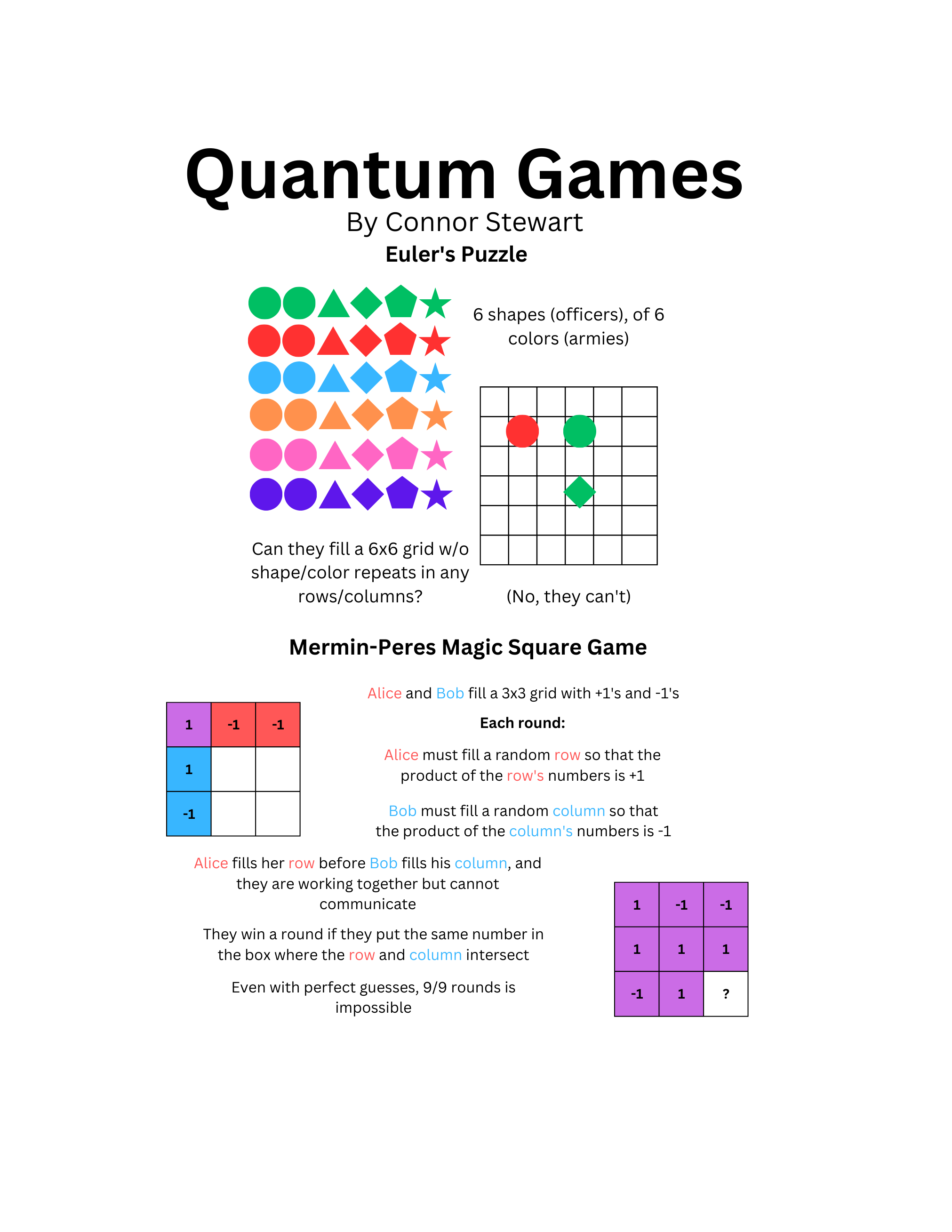No one likes the feeling of getting to the end of a puzzle and realizing one piece is missing, especially physicists. But physicists have found a way to finish unsolvable puzzles anyway: quantum mechanics, or the study of how subatomic particles move. There have been many puzzles across human history which all “classical” (or non-quantum) solutions have fallen short of solving, but quantum mechanics has opened the door to novel solutions.
The story starts 244 years ago, when Euler himself concocted the “Puzzle of the 36 Officers” as shown in the attached infographic, which remained unsolved for centuries and is essentially a more complicated form of sudoku. The solver must arrange 36 different officers (from a selection of 6 different ranks and armies, visualized in the infographic as shapes and colors) in a 6 x 6 grid so that there are no repeats of rank or army in any row or column (American Mathematical Society, n.d.). The solution to this centuries-old puzzle relies on two of the central pillars of quantum mechanics: superposition and entanglement. Superposition is the property of quantum particles to be multiple things, such as at multiple locations, at once. In these cases, the particle is said to be “in superposition” of these two states. While the particle can remain in superposition indefinitely, once measured, it must “collapse” into an absolute state (Caltech, n.d.). Two particles are entangled if the states they collapse into are linked, meaning one particle collapsing into one state signals the other must collapse the same (or it could be the opposite), no matter how far apart they are (Emspak, 2022).
In 2022, a group of Indian and Polish physicists demonstrated that Euler’s famous puzzle can finally be solved using these two principles, as long as the officers in each box are in a quantum superposition of both ranks and what army they are a part of (Rather et al, 2022). That is to say if the rank and army of one officer is to be collapsed, the rank and army of another officer is then decided. By using a computer to find the correct combination and configuration of entangled officers, they were able to fill a 6 x 6 board that fit Euler’s parameters in this hypothetical quantum army. By keeping officers in superposition, while entangling some officers with others, they were able to ensure that there were no “repeats” of either rank or army within any column or row, thanks to the uncertainty of what the ranks and armies were (Garisto, 2022). But while Euler’s puzzle is a fun thought-experiment, the computer-run simulation is a far cry from actually using real quantum particles to solve these puzzles.
The Mermin-Peres Magic Square Game, or MPMS Game for short, is also pictured in the infographic. It involves two players taking turns filling a 3 x 3 grid with -1’s and +1’s so that certain conditions are met. As is shown in the infographic, without any quantum advantage a perfect game is impossible if played normally. Since the game was created by quantum physicists, a quantum solution is possible, however. If instead of filling each square with a +1 or -1, they were filled with two quantum particles that are both in superposition of +1 and -1, these entities can be collapsed into either a +1 or -1, the product of which is the value for that square. Similarly to Euler’s puzzle, however, if these quantum entities are strategically entangled, the second player’s entries can tell what the first collapsed to without ever communicating. This is possible because one character fills their squares before the other without communicating, so if their values collapse into either +1 or -1 first, it determines what the other player’s entries will eventually collapse into. This has been dubbed quantum pseudo-telepathy, and it enables a perfect game (Ball, 2022).
What separates the MPMS Game from Euler’s puzzle is that in 2022 a group of Chinese researchers experimentally played a perfect game of it using real particles (Xu et al, 2022). By entangling photons (quantum particles that carry light) in a laboratory and placing them into their game, they were able to play quantum MPMS for real and they played a perfect 9 out of 9 game between 91.5 and 97% of the time, a rate that is reliably superior to the classical method of play (which is done with numbers on paper).
As fun as it is to use quantum mechanics to solve unbeatable puzzles, this research also shows remarkable promise in revolutionizing other fields of science. The pairs of particles used in the quantum MPMS Game are similar to something known as qubits, which are in superposition between +1 and -1, making them a promising faster form of transmitting information than normal “bits” used by computers that take the form of 0’s and 1’s (Microsoft Azure, n.d.). The way they can be logically applied to different puzzles provides a promising way to learn more about how qubits and quantum particles behave in a logically complex scenario.

References
Ball, P. (2022, October 25). Researchers Use Quantum “Telepathy” to Win an “Impossible” Game. Scientific American. https://www.scientificamerican.com/article/researchers-use-quantum-telepathy-to-win-an-impossible-game/
Caltech. (n.d.). What Is Superposition and Why Is It Important? Caltech Science Exchange. https://scienceexchange.caltech.edu/topics/quantum-science-explained/quantum-superposition
Feature Column from the AMS. (n.d.). American Mathematical Society. http://www.ams.org/publicoutreach/feature-column/fcarc-latinii1
Garisto, D. (2022, January 23). Euler’s 243-Year-Old “Impossible” Puzzle Gets a Quantum Solution. Wired. https://www.wired.com/story/eulers-243-year-old-impossible-puzzle-gets-a-quantum-solution/
Emspak, J. (2022, March 16). Quantum entanglement: A simple explanation. Space.com. https://www.space.com/31933-quantum-entanglement-action-at-a-distance.html#:~:text=Quantum%20entanglement%20is%20a%20bizarre
Rather, S. A., Burchardt, A., Bruzda, W., Rajchel-Mieldzioć, G., Lakshminarayan, A., & Życzkowski, K. (2022). Thirty-six Entangled Officers of Euler: Quantum Solution to a Classically Impossible Problem. Physical Review Letters, 128(8). https://doi.org/10.1103/physrevlett.128.080507
What is a Qubit? | Microsoft Azure. (n.d.). Azure.microsoft.com. https://azure.microsoft.com/en-us/resources/cloud-computing-dictionary/what-is-a-qubit/
Xu, J.-M., Zhen, Y.-Z., Yang, Y., Cheng, Z.-M., Ren, Z.-C., Chen, K., Wang, X., & Wang, H.-T. (2022). Experimental Demonstration of Quantum Pseudotelepathy. Physical Review Letters, 129(5). https://doi.org/10.1103/physrevlett.129.050402
